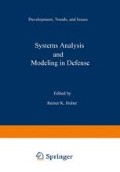Abstract
This article looks at the overlap between C3 and combat simulation, from the point of view of the developer of combat simulations and models. In this context, there are two different questions. The first is: How and to what extent should specific models of the C3 processes be incorporated in simulations of combat? Here the key point is the assessment of impact. In which types or levels of combat does C3 play a role sufficiently intricate and closely coupled with combat performance that it would significantly affect combat results? Conversely, when is C3 a known factor or modifier which can be simply accommodated without a specific detailed model being made for it?
Access this chapter
Tax calculation will be finalised at checkout
Purchases are for personal use only
Preview
Unable to display preview. Download preview PDF.
References
Theater-Level Gaming and Analysis Workshop for Force Planning, Vol. I-Proceedings, SRI International, 1977.
Military Strategy and Tactics, R. K. Huber, L. F. Jung, E. Reine, eds. Plenum, NY, 1974.
“C3 — The Last Ten Years,” Lt. Gen. H. Dickinson, Military Electronics/Countermeasures, January 1982.
“Desert Fox,” Strategy and Tactic, Vol. 87, 1981.
“Seatag,” Center for Advanced Research, Naval War College, Newport, R.I., 2nd Ed., 1978.
“Janus,” Conflict Simulation Code, C.A. Buzzell and G.C. Smith, Lawrence Livermore National Laboratory, Livermore, CA., January 1980.
“Modeling Tactical Military Operations,” A.W. Dobieski, Quest, Vol. 3, No. 1, 1979.
“Weapons and Tactics Analysis Center (WEPTAC) Operation Instructions,” NWC Technical Memoradum 4217, September 1980.
“The Ship Combat System Simulation,” Naval Ocean Systems Center, San Diego, CA. 92152, May 1980.
“Divisional Electronic Warfare Combat (DEWCOM) Model Overview,” Concepts Analysis Agency, Bethesda, Md., undated.
“The Warfare Environment Simulator (WES),” R.L. Brandenburg, NOSC, presented at CORS-TIMS-ORSA Meeting 3-6 May 1981.
Author information
Authors and Affiliations
Editor information
Editors and Affiliations
Rights and permissions
Copyright information
© 1984 Plenum Press, New York
About this chapter
Cite this chapter
Erickson, S.A. (1984). C3 and Combat Simulation—A Survey. In: Huber, R.K. (eds) Systems Analysis and Modeling in Defense. Springer, Boston, MA. https://doi.org/10.1007/978-1-4615-9370-6_17
Download citation
DOI: https://doi.org/10.1007/978-1-4615-9370-6_17
Publisher Name: Springer, Boston, MA
Print ISBN: 978-1-4615-9372-0
Online ISBN: 978-1-4615-9370-6
eBook Packages: Springer Book Archive

